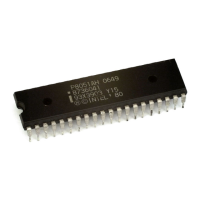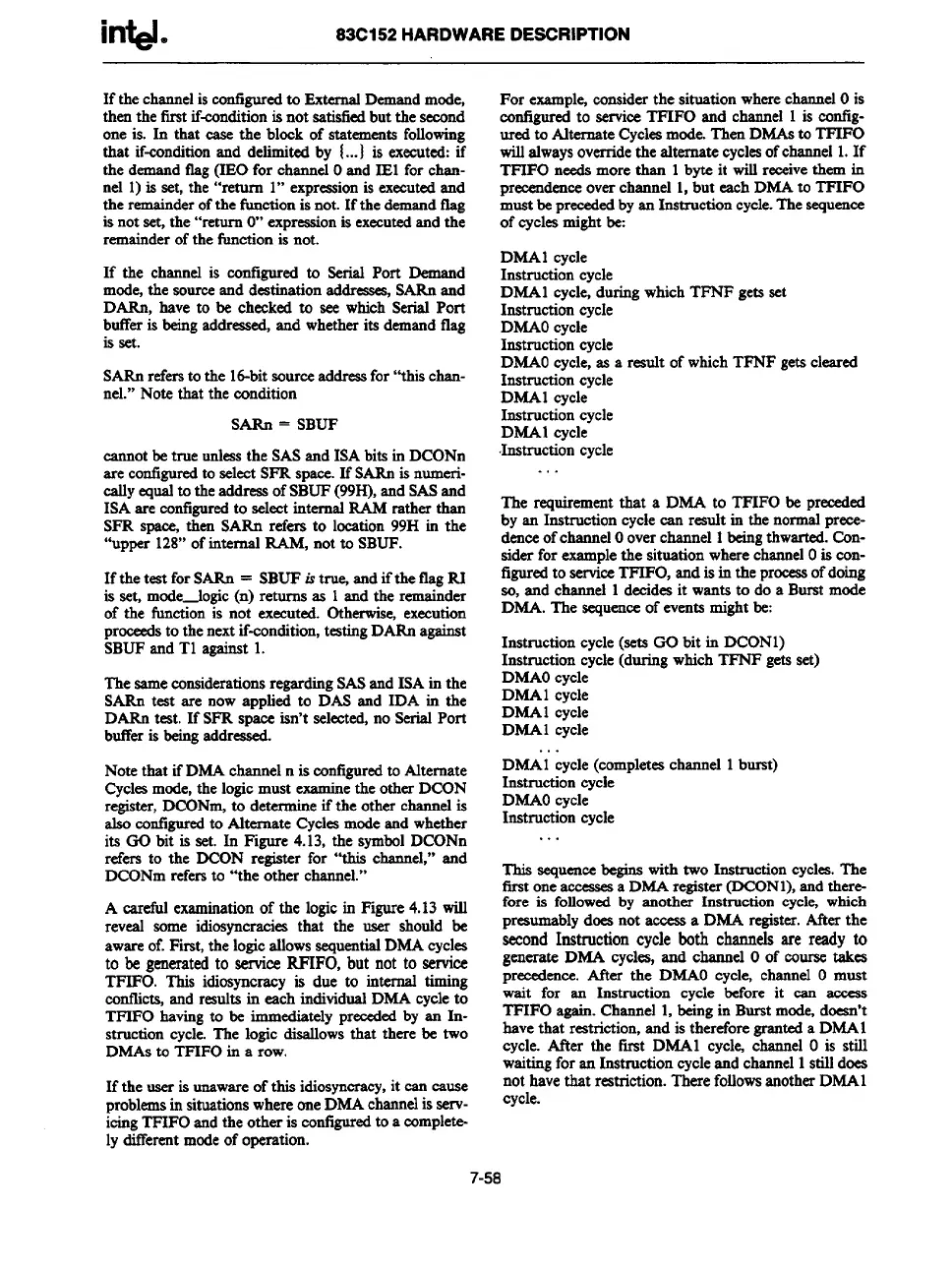intd.
83C152 HARDWARE DESCRIPTION
If thechannelk configuredto ExternalDeman
d mode,
thenthe tirst if-conditionis not satisfiedbutthe second
one k. In that case the block of statementsfollowing
that if-conditionand delimitedby {...) is executed:if
the demandflag(IEO for channelOand IE1 for chan-
nel 1)is set, the “return 1“ expressionis executedand
the remainderofthe tkwtion is not. If the d
crmmdtlag
is not set,the “return O“expressionis executedand the
remainderof the functionis not.
If the channel is configuredto serial Port Demand
mode,the sourceand destinationaddresses,SARnand
DARn, have to be checked to see which Serial Port
bufferis beingaddressed,and whetherits demandflag
is set.
SARnrefersto the id-bit sourceaddressfor “thischan-
nel.” Notethat the condition
SARn = SBUF
cannotbetrue unlessthe SASand ISAbitsin DCONn
are contlguredto selectSFR space.If SARnisnumeri-
callyequalto theaddressofSBUF(99H),and SASand
ISAare configuredto selectinternal RAM rather than
SFR space, then SARn refers to location99H in the
“upper 128”of internal RAM, not to SBUF.
If thetest forSARn = SBUFirt% andif the flagRI
is set, mode-logic (n) returns as 1and the remainder
of the functionis not executed.Otherwise,execution
proceedsto thenextif-condition,testingDARnagainst
SBUFand T1 against 1.
ThesameconsiderationsregardingSASand ISAin the
SARn teat are now applied to DAS and IDA in the
DARn test. If SFR space isn’tselected,no SerialPort
bufferis beingaddressed.
Notethat ifDMA channeln is configuredto Alternate
Cycleamode,the logicmust examinethe other DCON
register,DCON~ to determm
“ e if the other channelis
alsocordiguredto Alternate Cyclesmodeand whether
its 00 bit is set. In Figure 4.13, the symbolDCONn
refers to the DCON register for “this channel,” and
DCONmrefersto “the other channel.”
A carefulexaminationof the logicin Figure4.13will
reveal some idiosyncrasies that the user should be
awareof.First,the logicallowssequentialDMAcycles
to be generatedto service RFIFO, but not to service
TFIFO. This idiosyncrasy is due to internal timing
contlicts,and results in each individualDMA cycleto
TFIFO havingto be immediatelyprecededby an In-
struction cycle.The logic disallowsthat there be two
DMAsto TFIFO in a row.
If the useris unawareof this idiosyncrasy,it can cause
problemsinsituationswhereoneDMAchannelis serv-
icingTFIFO andthe other is configuredto a complete-
ly ditTerentmcdeof operation.
For example,considerthe situationwherechannelOis
configuredto serviceTFIFO and channel 1 is config-
uredto AlternateCyclesmode.Then DMAsto TFIFO
willalwaysoverridethe alternate cyclesofchannel1.If
TFIFO needsmore than 1byte it willreceivethem in
precedence overchannel 1,but eachDMAto TFIFO
mustbeprecededbyan Instructioncycle.Thesequemce
of cyclesmightbe:
DMA1 cycle
Instructioncycle
DMA1 CYC1%duringwhichTFNF getsset
Instructioncycle
DMAOcycle
Instructioncycle
DMAOcycle,as a result of whichTFNF getscleared
Instructioncycle
DMA1cycle
Instructioncycle
DMA1cycle
Instruction cycle
.,.
The requirementthat a DMA to TFIFO be preceded
by an Instructioncyclecan result in the normalprece-
denceofchannelOoverchannel1beingthwarted.Con-
sider for
examplethe situationwherechannelOis con-
figuredto serviceTFIFO, andisin the processofdoing
so, and channel 1decidesit wants to do a Burst mode
DMA. The sequenceof eventsmightbe:
Instructioncycle(sets GO bit in DCON1)
Instruction cycle(duringwhichTFNF getsset)
DMAOcycle
DMA1cycle
DMA1cycle
DMA1 cycle
. ..
DMAI cycle(completeschannel 1burst)
Instructioncycle
DMAOcycle
Instructioncycle
. . .
This sequencebeginswith two Instructioncycles.The
first one
acceswsa DMA registcx(DCONl), andthere-
fore is followed
by another Instruction cycle, which
presumablydoesnot access
a DMA register.After the
seeond Instruction cycle both channels are ready to
generate DMA CyCIS,and Chtllld OOfcoursetakes
preccdcmx. After the DMAOcycle, channel O must
wait for an
Instruction cycle before it can access
TFIFO again.Channel1,beingin Burst mode,doesn’t
havethat restriction,and is thereforegranteda DMA1
cycle. After the fnt DMA1 cyclej channel Ois still
waitingfor an Instmction cycleand channel1still dces
not havethat restriction.TherefoIlowsanotherDMA1
cycle.
7-58

